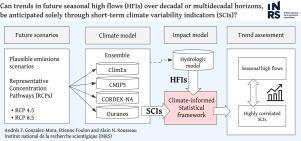利用短期气候变率指数间接估计雪占主导的流域未来季节性大流量趋势的气候知情统计框架
IF 6.3
1区 地球科学
Q1 ENGINEERING, CIVIL
引用次数: 0
摘要
气候变化下的水文循环加剧,导致洪水发生机制和极端水文事件的时间变异发生变化。为了更好地预测这些变化,广泛采用了综合气候模型、排放情景和水文模型的建模方法。然而,由于固有的不确定性,特别是来自水文模型的不确定性,它们的应用仍然具有挑战性。本研究旨在使用气候信息统计框架,利用一组短期气候变率指数(SCI)来间接估计季节性高流量指数(HFI)的时间变异性,这些指数在不同的汇总回顾期内表征了可能的原因机制。使用一系列气候模式、两个未来情景和31个SCIs来估计1997 - 2100年未来hfi的趋势,并使用加拿大魁北克南部两个积雪为主的流域作为概念验证。采用了包括线性和单调偏相关以及显著趋势检验在内的统计框架。结果表明,可以使用高度相关的sci作为代理来预测hfi未来的时间变异性。至少50%的HFI时间变率可以由单一的SCI来解释,如1 - 2周的累积总降水量或气候需求,或180天的有效干旱指数(EDI)等干旱指数。此外,高度相关的sci的显著趋势与hfi中观察到的显著趋势一致。这些发现为今后分析HFI的时间变化提供了宝贵的见解,特别是在旨在为区域缓解和适应战略提供信息的更全面的水管理分析中。本文章由计算机程序翻译,如有差异,请以英文原文为准。

A climate-informed statistical framework to indirectly estimate trends in future seasonal high flows in snow-dominated watersheds using short-term climate variability indices
The intensification of the hydrological cycle under climate change has brought changes in the temporal variability of flood-generating mechanisms and extreme hydrological events. To better anticipate these changes, modelling approaches integrating climate models, emissions scenarios, and hydrological models have been widely employed. However, their application remains challenging because of inherent uncertainties, in particular from hydrological models. This study aims to use a climate-informed statistical framework to indirectly estimate the temporal variability of seasonal high flows indices (HFI) using a set of short-term climate variability indices (SCI) characterizing likely causative mechanisms over different aggregated look-back periods. An ensemble of climate models, two future scenarios, and 31 SCIs were used to estimate future HFIs trends from 1997 to 2100 using as a proof of concept two snow-dominated watersheds in Southern Quebec, Canada. A statistical framework was used including linear and monotonic partial correlations along with significant trend tests. The results indicated that future temporal variability of HFIs could be anticipated using highly correlated SCIs as proxies. At least 50% of the HFI temporal variability was explained by a single SCI, such as cumulative total precipitation or climatic demands over 1 to 2 weeks, or drought indices like the Effective Drought Index (EDI) over 180 days. Furthermore, significant trends in highly correlated SCIs were consistent with significant trends observed in HFIs. These findings offer valuable insights for future analysis of HFI temporal variability, particularly in more comprehensive water management analyses aimed at informing regional mitigation and adaptation strategies.
求助全文
通过发布文献求助,成功后即可免费获取论文全文。
去求助
来源期刊

Journal of Hydrology
地学-地球科学综合
CiteScore
11.00
自引率
12.50%
发文量
1309
审稿时长
7.5 months
期刊介绍:
The Journal of Hydrology publishes original research papers and comprehensive reviews in all the subfields of the hydrological sciences including water based management and policy issues that impact on economics and society. These comprise, but are not limited to the physical, chemical, biogeochemical, stochastic and systems aspects of surface and groundwater hydrology, hydrometeorology and hydrogeology. Relevant topics incorporating the insights and methodologies of disciplines such as climatology, water resource systems, hydraulics, agrohydrology, geomorphology, soil science, instrumentation and remote sensing, civil and environmental engineering are included. Social science perspectives on hydrological problems such as resource and ecological economics, environmental sociology, psychology and behavioural science, management and policy analysis are also invited. Multi-and interdisciplinary analyses of hydrological problems are within scope. The science published in the Journal of Hydrology is relevant to catchment scales rather than exclusively to a local scale or site.
 求助内容:
求助内容: 应助结果提醒方式:
应助结果提醒方式:


